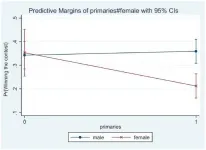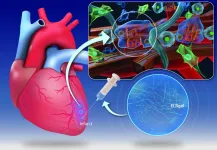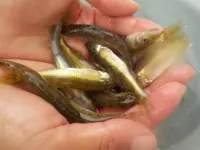(Press-News.org) For the first time, scientists have assessed how many corals there are in the Pacific Ocean--and evaluated their risk of extinction.
While the answer to "how many coral species are there?" is 'Googleable', until now scientists didn't know how many individual coral colonies there are in the world.
"In the Pacific, we estimate there are roughly half a trillion corals," said the study lead author, Dr Andy Dietzel from the ARC Centre of Excellence for Coral Reef Studies at James Cook University (Coral CoE at JCU).
"This is about the same number of trees in the Amazon, or birds in the world."
The results are crucial for the research and conservation of corals and coral reefs as they decline across the world due to the effects of climate change.
"We need to know the abundance of a species to assess its risk of extinction," Dr Dietzel said. "However, there is very little data on most of Earth's wild animal and plant species--not just corals."
Dr Dietzel said the eight most common coral species in the region each have a population size greater than the 7.8 billion people on Earth.
The findings suggest that while a local loss of coral can be devastating to coral reefs, the global extinction risk of most coral species is lower than previously estimated.
Extinctions could instead unfold over a much longer timeframe because of the broad geographic ranges and huge population sizes of many coral species.
Co-author Professor Sean Connolly, from Coral CoE at JCU and the Smithsonian Tropical Research Institute, said the study's new analysis of the 80 species considered by the IUCN to have an elevated extinction risk shows that 12 of those species have estimated population sizes of more than one billion colonies.
"As an example, the finger-coral, Porites nigrescens, ranks amongst the ten most abundant species we examined. It's also not considered to be highly susceptible to coral bleaching--yet it is currently listed by IUCN as vulnerable to global extinction," Prof Connolly said.
Co-author Professor Michael Bode from Coral CoE at JCU and the Queensland University of Technology said, "One third of the rarest species in our analysis--covering the bottom ten percent of species abundances--are nonetheless listed by the IUCN as being of Least Concern."
The study measured the population sizes of more than 300 individual coral species on reefs across the Pacific Ocean, from Indonesia to French Polynesia. The scientists used a combination of coral reef habitat maps and counts of coral colonies to estimate species abundances.
Co-author Professor Terry Hughes from Coral CoE at JCU said the study results have major implications for managing and restoring coral reefs.
"We counted an average of 30 corals per square metre of reef habitat. This translates into tens of billions of corals on the Great Barrier Reef--even after recent losses from climate extremes," Prof Hughes said.
"Coral restoration is not the solution to climate change. You would have to grow about 250 million adult corals to increase coral cover on the Great Barrier Reef by just one percent."
He said the study highlights the opportunity for action to mitigate the threats to reef species--and well before climate change causes global extinctions--to make an eventual recovery of reef coral assemblages possible.
"The challenge now is to protect wild populations of corals, because we could never replace more than a tiny percentage of them. Prevention is better than cure," Prof Hughes said.
"Given the huge size of these coral populations, it is very unlikely that they face imminent extinction. There is still time to protect them from anthropogenic heating, but only if we act quickly on reducing greenhouse gas emissions."
INFORMATION:
PAPER
Dietzel A, Bode M, Connolly S, Hughes T. (2021). 'The population sizes and global extinction risk of reef-building coral species at biogeographic scales'. Nature Ecology & Evolution. DOI: 10.1038/s41559-021-01393-4
CONTACT
Dr Andreas Dietzel (Townsville, Australia)
P: +61 (0)432 916 224
E: andreas.dietzel@my.jcu.edu.au
Prof Sean Connolly (Panama, Central America)
P: (available on request)
E: ConnollyS@si.edu
Prof Michael Bode (Brisbane, Australia)
P: +61 (0)414 108 439
E: michael.bode@qut.edu.au
Prof Terry Hughes (Townsville, Australia)
P: +61 (0)400 720 164
E: terry.hughes@jcu.edu.au
FOR FURTHER INFORMATION
Melissa Lyne/ Coral CoE at JCU (Sydney, Australia)
P: +61 (0) 415 514 328
E: melissa.lyne@jcu.edu.au
UNIVERSITY OF CALIFORNIA, SAN FRANCISCO
UNIVERSITY OF TORONTO
Toronto, ON - Children in the United States who have more screen time at ages 9-10 are more likely to develop binge-eating disorder one year later, according to a new national study.
The study, published in the International Journal of Eating Disorders on March 1, found that each additional hour spent on social media was associated with a 62% higher risk of binge-eating disorder one year later. It also found that each additional hour spent watching or streaming television or movies led to a 39% ...
HANOVER, N.H. - March 1, 2020 - During World War II, British intelligence agents planted false documents on a corpse to fool Nazi Germany into preparing for an assault on Greece. "Operation Mincemeat" was a success, and covered the actual Allied invasion of Sicily.
The "canary trap" technique in espionage spreads multiple versions of false documents to conceal a secret. Canary traps can be used to sniff out information leaks, or as in WWII, to create distractions that hide valuable information.
WE-FORGE, a new data protection system designed at Dartmouth's Department ...
Assessing a drug compound by its activity, not simply its structure, is a new approach that could speed the search for COVID-19 therapies and reveal more potential therapies for other diseases.
This action-based focus -- called biological activity-based modeling (BABM) -- forms the core of a new approach developed by National Center for Advancing Translational Sciences (NCATS) researchers and others. NCATS is part of the National Institutes of Health (NIH). Researchers used BABM to look for potential anti-SARS-CoV-2 agents whose actions, not their structures, are similar to those of compounds already shown to be effective.
NCATS scientists ...
The hidden social, environmental and health costs of the world's energy and transport sectors is equal to more than a quarter of the globe's entire economic output, new research from the University of Sussex Business School and Hanyang University reveals.
According to analysis carried out by Professor Benjamin K. Sovacool and Professor Jinsoo Kim, the combined externalities for the energy and transport sectors worldwide is an estimated average of $24.662 trillion - the equivalent to 28.7% of global Gross Domestic Product.
The study found that the true cost of coal should be more than twice as high as current prices when factoring in the currently unaccounted ...
A study by two researchers at the UPF Department of Political and Social Sciences (DCPIS) has examined the effect of selecting party leaders by direct vote by the entire membership (a process known in southern Europe as "primaries" and in English-speaking countries as "one-member-one -vote", OMOV) on the likelihood of a woman winning a leadership competition against male rivals.
Javier Astudillo and Andreu Paneque, a tenured lecturer and PhD with the DCPIS, respectively, and members of the Institutions and Political Actors Research Group, are the authors of the article published recently in the journal ...
TROY, N.Y. -- The era of widespread remote learning brought about by the COVID-19 pandemic requires online testing methods that effectively prevent cheating, especially in the form of collusion among students. With concerns about cheating on the rise across the country, a solution that also maintains student privacy is particularly valuable.
In research published today in npj Science of Learning, engineers from Rensselaer Polytechnic Institute demonstrate how a testing strategy they call "distanced online testing" can effectively reduce students' ability to receive help from one another in order to score higher on a test taken at individual homes during social distancing.
"Often in remote online exams, students ...
A group of researchers including Tiago Falótico, a Brazilian primatologist at the University of São Paulo's School of Arts, Sciences and Humanities (EACH-USP), archeologists at Spain's Catalan Institute of Human Paleoecology and Social Evolution (IPHES) and University College London in the UK, and an anthropologist at the Max Planck Institute for Evolutionary Anthropology in Germany, have published an article in the Journal of Archeological Science: Reports describing an analysis of stone tools used by bearded capuchin monkeys (Sapajus libidinosus) that inhabit ...
Researchers at CÚRAM, the SFI Research Centre for Medical Devices based at National University of Ireland Galway, and BIOFORGE Lab, at the University of Valladolid in Spain, have developed an injectable hydrogel that could help repair and prevent further damage to the heart muscle after a heart attack.
The results of their research have just been published in the prestigious journal Science Translational Medicine.
Myocardial infarction or heart disease is a leading cause of death due to the irreversible damage caused to the heart muscle (cardiac tissue) during a heart attack. The regeneration of cardiac tissue is minimal so that the damage caused cannot be repaired by itself. ...
Because walleyes are a cool-water fish species with a limited temperature tolerance, biologists expected them to act like the proverbial "canary in a coal mine" that would begin to suffer and signal when lakes influenced by climate change start to warm. But in a new study, a team of researchers discovered that it is not that simple.
"After analyzing walleye early-life growth rates in many lakes in the upper Midwest over the last three decades, we determined that water clarity affects how growth rates of walleyes change as lakes start to warm," said Tyler Wagner, Penn State adjunct professor of fisheries ecology. ...
The Earth's surface is subject to continual changes that dynamically shape natural landscapes. Global phenomena like climate change play a role, as do short-term, local events of natural or human origin. The 3D Geospatial Data Processing (3DGeo) research group of Heidelberg University has developed a new analysis method to help improve our understanding of processes shaping the Earth's surface like those observed in coastal or high-mountain landscapes. Unlike conventional methods that usually compare two snapshots of the topography, the Heidelberg approach can determine - fully automatically and over long periods - when and where surface alterations occur and which type of associated changes they represent.
The method, known ...





